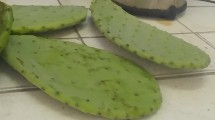Abstract
This paper describes the removal of Cr(VI) using the combination of bacterial reduction of Cr(VI) to Cr(III) by wood husk–packed column containing the Cr(VI)-reducing biofilm followed by Cr(III) removal using the coagulation-flocculation technique. The chromium removal process was carried out at the laboratory-scale for 90 days using different batches of Cr(VI) ranging from 35 to 231 mg L−1. Analysis of variance (ANOVA) showed a high coefficient of determination (R2) value of 0.9941, thus ensuring a satisfactory adjustment of the second-order regression model with the experimental data. The experimental observations were in reasonable agreement with the modeled values. The biofilm was able to completely reduce 100 mg L−1 Cr(VI) in 6 h while a longer contact time (18 h) was needed for higher Cr(VI) concentrations. In this study, ORP (oxidation-reduction potential) was used as the control parameter during the Cr(VI) reduction process. The coagulation/flocculation process using the combination of alum and polyacrylamide results in complete removal of color, 85% Cr(III), and 97% turbidity. The field emission scanning electron microscope (FESEM) analysis of the biofilm revealed the embedding of bacterial cells in extracellular polymeric substances (EPS). This study successfully demonstrated the potential application of a bacterial biofilm and chemical systems to remove chromium contamination from water systems.




Similar content being viewed by others
References
Al-Malack, M. H., Abuzaid, N. S., & El-Mubarak, A. H. (1998). Coagulation of polymeric wastewater discharged by a chemical factory. Water Research, 33, 521–529.
Bandara, T., Franks, A., Xu, J., Bolan, N., Wang, H., & Tang, C. (2020). Chemical and biological immobilization mechanisms of potentially toxic elements in biochar-amended soils. Critical Reviews in Environmental Science and Technology, 50(9), 903–978.
Chirwa, N., & Evans, M. (1997). Hexavalent chromium reduction by Bacillus sp. in packed-bed bioreactor. Environmental Science & Technology, 31, 1446–1451.
Cordoba, A., Vargas, P., & Dussan, J. (2008). Chromate reduction by Arthrobacter CR47 in biofilm packed bed reactors. Journal of Hazardous Materials, 151, 274–279.
Ganguli, A., & Tripathi, A. K. (2002). Bioremediation of toxic chromium from electroplating effluent by chromate-reducing Pseudomonas aeruginosa A2Chr in two bioreactors. Applied Microbiology and Biotechnology, 58, 416–420.
Lee, W., & Westerhoff, P. (2006). Dissolved organic nitrogen removal during water treatment by aluminium sulphate and cationic polymer. Water Research, 40, 3767–3774.
Liptak, B. G. (1979). Instrumentation in the processing industries. Chilton Bk Co: New York.
Michel, C., Jean, M., Coulon, S., Dictor, M. C., Delorme, F., Morin, D., & Garrido, F. (2007). Biofilms of As(III)-oxidising bacteria: formation and activity studies for bioremediation process development. Applied Microbiology and Biotechnology, 77, 457–467.
Pal, A., & Paul, A. K. (2002). Microbial extracellular polymeric substances: central elements in heavy metal bioremediation. Indian Journal of Microbiology, 48, 49–64.
Wuertz, S., Bioshop, P., & Wilderer, P. (2003). Biofilms in wastewater treatment. United States, America: IWA Publishing.
Yao, Y., Hu, L., Li, S., Zeng, Q., Zhong, H., & He, Z. (2020). Exploration on the bioreduction mechanisms of Cr(VI) and Hg(II) by a newly isolated bacterial strain Pseudomonas umsongensis CY-1. Ecotoxicology and Environmental Safety, 201, 110850.
Yuehuei, H., & Richard, J. (1997). Laboratory methods for studies of bacterial adhesion. Microbiological Methods, 30, 141–152.
Zakaria, Z. A., Zakaria, Z., Surif, S., & Ahmad, W. A. (2007). Hexavalent chromium reduction by Acinetobacter haemolyticus isolated from heavy-metal contaminated wastewater. Journal of Hazardous Materials, 146, 30–38.
Acknowledgments
The authors acknowledge the contributions by Mrs. Nurfadillah Mohammed and Mr. Shaik Muhammad Hasbullah Shaik Ismail for the excellent data collection. Also, thanks are due to Mr. Jefri Samin from the Material Science Laboratory, School of Mechanical Engineering, Universiti Teknologi Malaysia, for the exceptional FESEM-EDAX work.
Author information
Authors and Affiliations
Corresponding author
Additional information
Publisher’s Note
Springer Nature remains neutral with regard to jurisdictional claims in published maps and institutional affiliations.
Rights and permissions
About this article
Cite this article
Zakaria, Z.A., Ahmad, W.A. Cr(VI) Removal Using the Combination of the Cr(VI)-Resistant and Cr(VI)-Reducing Biofilm and the Alum-Polyacrylamide. Water Air Soil Pollut 231, 490 (2020). https://doi.org/10.1007/s11270-020-04860-z
Received:
Accepted:
Published:
DOI: https://doi.org/10.1007/s11270-020-04860-z




